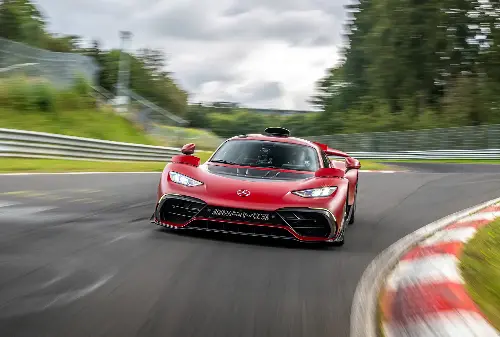
In many, but not all cases, more is better. When it comes to the next generation of the world's vehicles, the balance of more power with more efficiency is a tremendous hurdle.
It's a hurdle that comes from wanting to deliver to meet customer expectations, and even exceed them. In that quest, automakers also need to be cognizant of the varied but strict emissions regulations put in place by governments globally and associated sustainability goals that their companies have created.
A new generation of vehicle architectures, evolving exterior and materials design, innovative technologies and advancing battery chemistry targets this balance in earnest.
To see what's next, automakers are previewing technological advances via concept vehicles and record-setting. The latest records belong to Mercedes-Benz and Mercedes-AMG, the company's performance vehicles arm.
In October, AMG announced that the 1,049-brake-horsepower Mercedes-AMG ONE, a hypercar with Formula 1 powertrain technology, had broken its own Nürburgring lap record, knocking six seconds off its time at a track long regarded as the gold standard in sports car record setting.
That time, 6:29.090 minutes made the ONE the first production car to dip below 6:30 in track history.
The ONE has a powertrain made up of a turbocharged 1.6-litre V6 hybrid engine that is paired with four electric motors. The technology is linked through the Mercedes family tree to the powertrain in the Mercedes-AMG C 63 and the forthcoming new engine family that will serve as the power base for Mercedes-Benz vehicles, starting with the upcoming CLA-Class models.
Those CLA-Class models have been previewed via the Vision EQXX battery-electric concept car, which recently set a record of its own, traveling a distance of 3,717 kilometers (2,309 miles) on a high-speed track in 24 hours. That distance is equivalent to driving from Norway to Istanbul, and about the distance between New York City and Santa Barbara, California.
Using a total of 40 charging stops of varying lengths and three teams of two, the Mercedes-Benz team set out to discover the full power of the optimized efficiency of the EQXX. Each charging stop lasted approximately 10 minutes.
Driving fast and hot and cold ambient temperatures decrease the range of a battery. Engineers drove the EQXX when the air temperature ranged from 55.4°F at night to 84.2°F during the day. And, they drove at an average rate of 154.9 kilometers per hour (96.2 miles per hour).
Mercedes engineers have developed two new batteries that will feature upcoming powertrains. Two batteries, one lithium-ion and one nickel-metal hydride, are ready, but a third is in the works for AMG products, company representatives confirmed to Newsweek during a media preview of future technologies in Sindelfingen, Germany.
AMG recently announced a new high-performance model is on the horizon. The SUV will be the first model the company has built from the ground up and will use the new AMG.EA electric high-performance platform. Testing of the model will commence this winter.
AMG models are noted for their high-performance outputs and handling dynamics, both things that can be enhanced and strained under the weight and safety requirements of a battery-electric powertrain.
In conversation in Germany, Mercedes engineers were clear. They aren't looking to develop a vehicle with the best range or quickest off-the-line time at the sacrifice of everything else. The automaker is focused on well-rounded performance, a checklist that is dependent on the objectives of the vehicle. This will ensure that the vehicle is the best it can be for the customer.
Related Articles
- Jaguar Chases Enzo Ferrari's Legendary Comment with New Sedan
- Jaguar Brand Reimagined and Revealed
- Mercedes-Benz Leans in on Efficiency, Adaptability for New Models
- Change This, Not That: 2024 Hyundai Santa Fe Review
